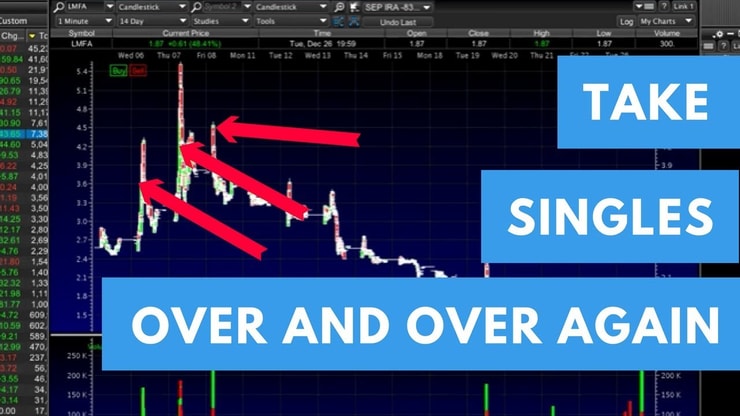Many traders misjudge their trades.
They automatically assume that if the trade makes money, it’s good…and if it doesn’t, it’s bad.
That’s a bigtime newbie mistake.
And one that can be catastrophic if you continue to think that way.
Today, I will walk you through two “good” trades I recently had…one made money, and the other didn’t.
If you want to take your trading to the next level, then pay attention…this is the mindset you’ll need to develop.
Table of Contents
Before I Break Down These Two Trades
Before I tell you about my two trades from last week, I feel like it’s a good idea to tell you first about my thought process before entering a trade.
I use a system called P.R.E.P.A.R.E.
If you haven’t heard of it before, here’s how it works:
The Power of PREPARE: A Pro Trader’s Checklist for Success

In the trading world, staying curious and questioning everything can make all the difference. When individuals approach me, asking the secret behind my consistent streak of successful trades, I open up about my guiding tool: the checklist.
This isn’t just any list; it’s a tool honed over the years that assists in making informed decisions. Let’s dive deep into my process, which revolves around the mnemonic ‘PREPARE.’
P: Pattern/Price
This is where the price of the stock comes into play. I zoom into its current state, identifying areas of support, resistance, and its behavior across different time frames. When analyzing a stock recently, I noticed a pattern I always look out for – the panic sell-off near the start of trading.
R: Risk/Reward
How do the potential rewards compare to the risks? It’s vital to balance them. I seek out trades that offer a risk vs. reward of 3:1 or more. Assessing the potential risks and rewards helps me gauge the overall viability of a trade.
E: Ease of Entry
Is there ample volume? Will the exit be smooth or rocky? Monitoring the stock’s price action provides insights into this. A stock’s liquidity and my ability to navigate it without hiccups is crucial.
P: Past Performance/History of Spiking
Here, I assess whether the stock has a track record of explosive growth or not. A stock with a history of significant moves often signals potential future activity.
A: At What Time Is It? / Personal Schedule
Timing is everything in trading. Sometimes, even with a promising setup, I might step back if other commitments or conditions aren’t conducive. It’s not just about the trade; it’s also about being in the right state of mind.
R: Reason/Catalyst
Every stock move is often backed by a reason or a catalyst. Whether it’s company news, sectoral shifts, or global trends, knowing what’s driving a stock’s movement is crucial.
E: Market Environment
While individual stocks have their dynamics, they don’t exist in a vacuum. The broader market mood can heavily influence even the most promising trades. Thus, always keeping a pulse on the overall market sentiment is non-negotiable.
Now that you’ve got a better idea of how I’m sizing up my trade candidates allow me to tell you about these two trades from last week.
You can check out the checklist here.
The first was in the ticker symbol VTGN.
A Good Loss In VTGN

One thing I’m always trying to do is identify winning patterns. And that’s something that drew me into trading the ticker symbol VTGN last Thursday.
Why?
Because it was reported that billionaire and Wall Street Legend Stevie Cohen’s fund invested in the company.
From experience, I knew that his small-cap buys did well.
For example, I recall BNOX, CYBN, and PRAX all performing well on his stock purchases.
Whenever a big player shows a vote of confidence in a small-cap company, I call that a legitimizer.
The goal was to buy and sell the stock the next day because I got in after hours.
It is very much in line with my weekend strategy.
Of course, Friday’s action in the market was wild after the jobs numbers. The market initially sold off hard following the report and then rallied after the first hour or so of trading.
Given the ugly market on Friday, I had no choice but to cut losses short.
I ended up losing $378 on this trade.
Nonetheless, I felt like this trade made a lot of sense. I recognized a winning pattern, got in at a level that wasn’t chasing, and had a reasonable target.
It didn’t work out…but I still rated it as a good trade.
My Almost Weekend Winner In TTOO

My goal was to buy TTOO and hold it over the weekend.
Why?
Several reasons.
First, I loved the setup.
It was a first green day former runner.
If you don’t know what that means, click play on the video below:
Former runners can repeat from my experience.
And the first green day buy after a significant decline is a good level to get in from a risk vs. reward basis.
In addition, what really drove me to take the trade was that the stock had a catalyst.
All these combined made it a good setup for me.
I got in at around $.258.
The plan was to take into the weekend and get out on Monday. But I saw the stock take off in the after-hours, so I decided to take a 9.3% profit.
Notice why I gave my reasons on why I felt both trades were good. None of them had to do with my PnL.
The best traders don’t think in terms of PnL. They think in terms of risk vs. reward.
Study check, retweet/favorite this if you're still up studying, reviewing your @StocksToTrade scans or making your watchlist for tomorrow….how well prepared will you be? Remember that preparation + discipline are the keys to using the markets to change you/your family's lives!
— Timothy Sykes (@timothysykes) October 10, 2023
Ready To Elevate Your Trading Game? 📈

Unlock the secrets of successful trading by understanding the difference between good and bad trades.
Join our upcoming live training sessions to dive deep into expert strategies and market analysis.
🚀 Discover the power of a risk vs. reward mindset.
🚀 Learn how to read market cues and adapt to changing conditions.
🚀 Explore top-notch analysis for confident decision-making.
🚀 Master the art of trading, regardless of PnL.
Don’t miss out on this opportunity to enhance your trading skills.






Leave a reply